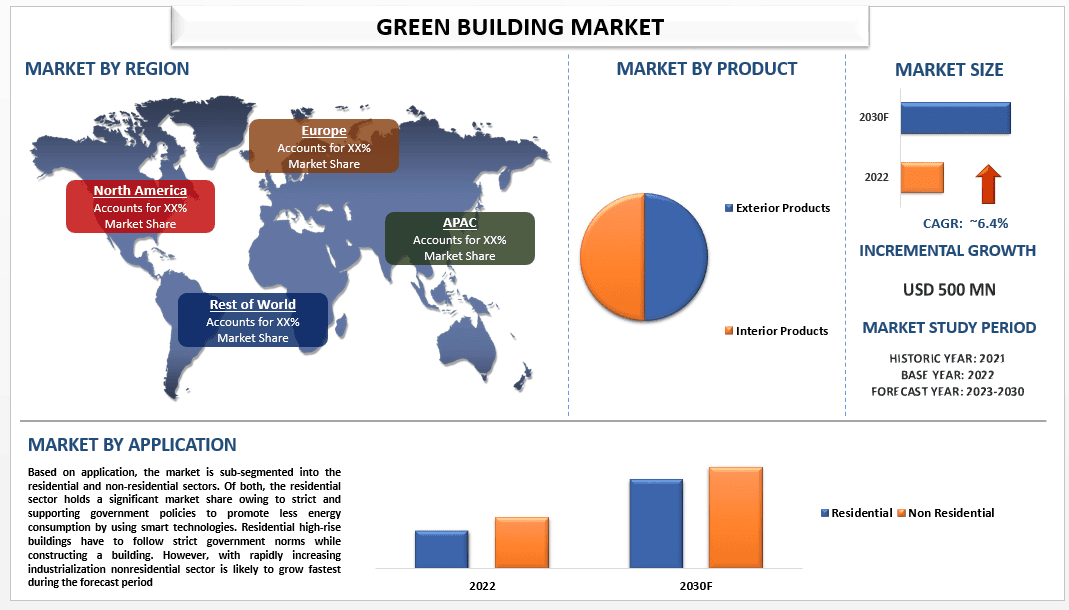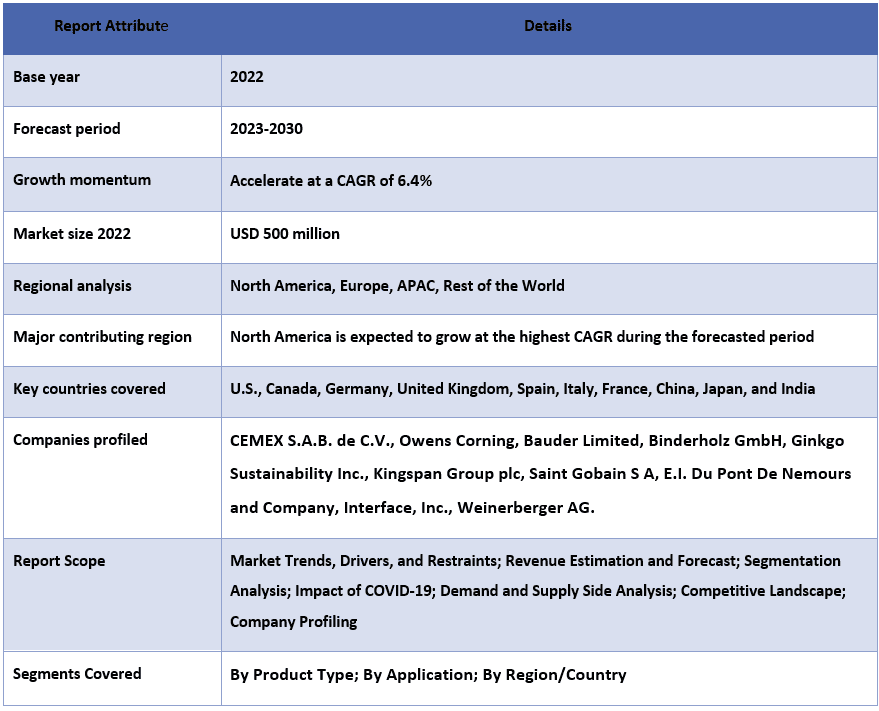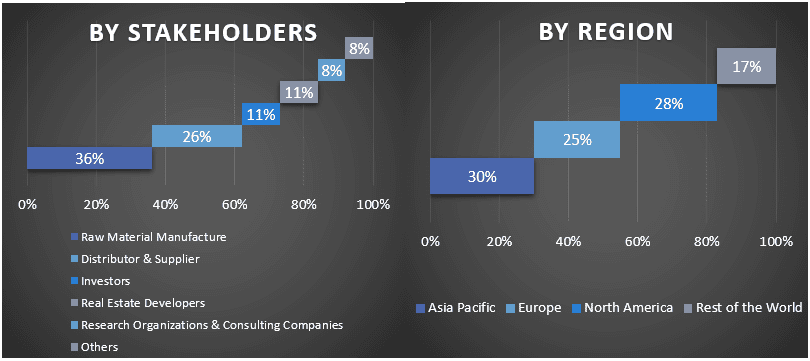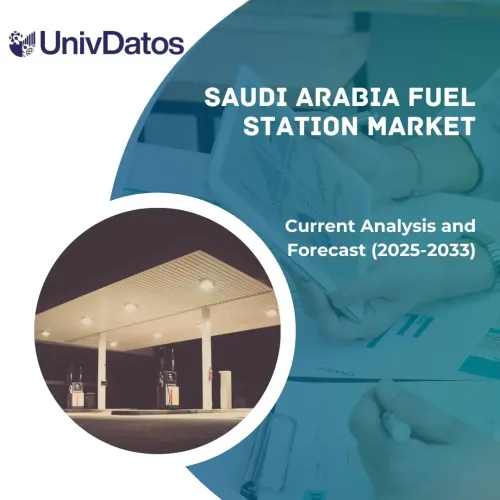
预计绿色建筑市场在预测期内将以约6.4%的强劲复合年增长率增长。绿色建筑材料支持环保、持久的建筑,从而减少能源消耗。这些环保的建筑材料可以使环境受益。玻璃纤维、再生金属、木材和矿物棉都是绿色建筑中使用的无毒、可再生材料的例子。该行业的解决方案利用可再生能源的现场发电,包括太阳能、生物质能、风能和水力发电。因此,低能耗是市场收入增长的主要因素。此外,根据国会预算办公室2021年4月的数据,在过去的二十年里,联邦政府向绿色建筑市场提供了7000亿美元的资金。 印度绿色建筑委员会(IGBC)在过去几年中一直与多个中央和邦政府部门直接合作,以推动该国绿色建筑运动的发展。
市场上一些主要的运营企业包括墨西哥水泥公司、欧文斯科宁、Bauder Limited、Binderholz GmbH、Ginkgo Sustainability Inc.、金斯潘集团、圣戈班集团、杜邦公司、Interface, Inc.、维纳博格股份公司。
报告中提出的见解
“在产品中,外部产品细分市场预计在预测期内将以高复合年增长率增长”
根据产品类型,绿色建筑市场分为外部产品和内部产品。外部产品包括雨水收集系统、太阳能系统、智能照明系统、热通风空调系统和水处理厂,它们是绿色建筑中最重要的组成部分,并被广泛使用,因此,外部子细分市场占据了可观的市场份额。
“在应用中,住宅部门在2022年占据了重要的市场份额”
根据应用,市场分为住宅和非住宅部门。其中,住宅部门占据了重要的市场份额,这归功于政府为推广使用智能技术以减少能源消耗而制定的严格和支持性政策。住宅高层建筑在建造时必须遵守严格的政府规范。然而,随着工业化的迅速发展,非住宅部门预计在预测期内增长最快。
绿色建筑市场报告覆盖范围

“北美预计在预测期内将以高复合年增长率增长”
由于人们对可持续建筑的认识不断提高,以及对低能耗系统的需求不断增长,预计北美市场在预测期内将录得最高的增长率。此外,该地区日益严重的工业污染以及严格的环境法规预计将推动工业部门的市场增长。由于政府维护活动和举措的增加,这些地区的建筑行业的维护和维修活动有所增加,这进一步为该地区绿色建筑材料市场的增长做出了重大贡献。
购买本报告的理由:
- 该研究包括经过认证的关键行业专家验证的市场规模和预测分析。
- 该报告快速回顾了整个行业的整体表现。
- 该报告对主要的行业同行进行了深入分析,主要关注关键业务财务、产品组合、扩张战略和近期发展。
- 详细检查行业中存在的驱动因素、限制、主要趋势和机遇。
- 该研究全面涵盖了跨不同细分市场的市场。
- 对行业进行深入的区域层面分析。
定制选项:
全球绿色建筑市场可以根据要求或任何其他市场细分进行进一步定制。除此之外,UMI 了解到您可能有自己的业务需求,因此请随时与我们联系以获取完全符合您要求的报告。
目录
全球绿色建筑市场分析(2023-2030)的研究方法
分析历史市场、评估当前市场以及预测绿色建筑市场的未来市场,是创建和分析全球主要区域绿色建筑市场采用情况的三个主要步骤。 进行了详尽的二级研究,以收集历史市场数据并评估当前市场规模。 其次,为了验证这些见解,考虑了许多发现和假设。 此外,还与全球绿色建筑市场价值链上的行业专家进行了详尽的初步访谈。 通过初步访谈对市场数据进行假设和验证后,我们采用了自上而下/自下而上的方法来预测完整的市场规模。此后,采用市场细分和数据三角测量方法来评估和分析行业相关细分市场和子细分市场的市场规模。 详细的方法如下所述:
历史市场规模分析
第 1 步:深入研究二级来源:
进行了详细的二级研究,通过公司内部来源(如年度报告和财务报表、绩效演示文稿、新闻稿等)以及外部来源(包括期刊、新闻和文章、政府出版物、竞争对手出版物、行业报告、第三方数据库和其他可靠的出版物),获取绿色建筑市场的历史市场规模。
第 2 步:市场细分:
在获得绿色建筑市场的历史市场规模后,我们进行了详细的二级分析,以收集主要区域不同细分市场和子细分市场的历史市场见解和份额。 报告中包括的主要细分市场包括产品类型和应用。 此外,还进行了国家/地区层面的分析,以评估该地区测试模型的总体采用情况。
第 3 步:因素分析:
在获得不同细分市场和子细分市场的历史市场规模后,我们进行了详细的因素分析,以评估绿色建筑市场的当前市场规模。 此外,我们使用绿色建筑市场的产品类型和应用等因变量和自变量进行了因素分析。 考虑到全球绿色建筑市场领域的顶级合作、兼并和收购、业务扩张和产品发布,对需求和供应侧情景进行了透彻的分析。
当前市场规模估算和预测
当前市场规模:基于以上 2 个步骤的可行见解,我们得出了当前市场规模、全球绿色建筑市场的关键参与者以及细分市场的市场份额。 所有必需的百分比份额拆分和市场细分均使用上述二级方法确定,并通过初步访谈进行了验证。
估算和预测:对于市场估算和预测,对包括驱动因素和趋势、限制因素以及利益相关者可获得的机会在内的不同因素分配了权重。 在分析这些因素后,应用相关的预测技术,即自上而下/自下而上的方法,以得出 2030 年全球主要市场不同细分市场和子细分市场的市场预测。 用于评估市场规模的研究方法包括:
- 该行业的市场规模,就收入(美元)和国内主要市场绿色建筑市场的采用率而言
- 所有百分比份额、拆分以及细分市场和子细分市场的细分
- 全球绿色建筑市场中按产品提供的关键参与者。 此外,这些参与者为在快速增长的市场中竞争而采取的增长策略
市场规模和份额验证
初步研究:与主要区域的关键意见领袖 (KOL)(包括高层管理人员(CXO/副总裁、销售主管、营销主管、运营主管、区域主管、国家主管等))进行了深入访谈。 然后总结初步研究结果,并进行统计分析以证明既定的假设。 来自初步研究的输入与二级调查结果相结合,从而将信息转化为可行的见解。
不同区域的初步参与者划分

市场工程
采用数据三角测量技术来完成总体市场评估,并得出全球绿色建筑市场每个细分市场和子细分市场的精确统计数据。 在研究了全球绿色建筑市场产品类型和应用领域的各种参数和趋势后,数据被分为几个细分市场和子细分市场。
全球绿色建筑市场研究的主要目标
该研究指出了全球绿色建筑市场的当前和未来市场趋势。 投资者可以获得战略见解,从而根据研究中执行的定性和定量分析来决定投资。 当前和未来的市场趋势决定了区域层面市场的整体吸引力,为行业参与者提供了一个利用未开发市场从先发优势中获益的平台。 研究的其他定量目标包括:
- 分析绿色建筑市场的当前和预测市场规模(按价值(美元)计)。 此外,分析不同细分市场和子细分市场的当前和预测市场规模
- 研究中的细分市场包括产品类型和应用领域
- 定义和分析绿色建筑行业的监管框架
- 分析涉及各种中介机构的价值链,以及分析行业的客户和竞争对手行为
- 分析主要区域绿色建筑市场的当前和预测市场规模
- 报告中研究的区域的主要国家/地区包括亚太地区、欧洲、北美洲和世界其他地区
- 绿色建筑市场的公司简介以及市场参与者为在快速增长的市场中维持发展而采取的增长战略
- 对行业进行深入的区域层面分析
相关 报告
购买此商品的客户也购买了










